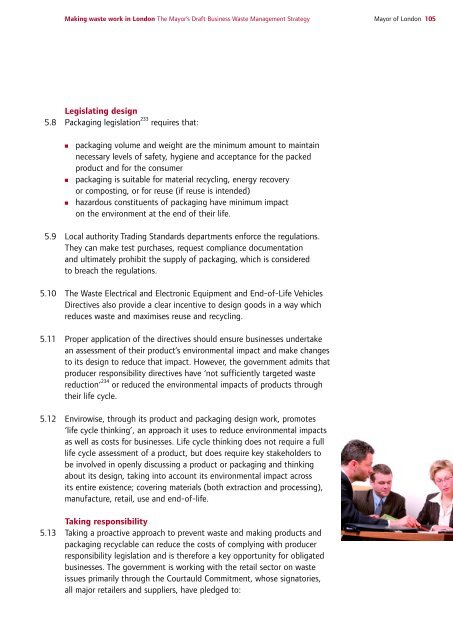Draft Business Waste Strategy PDF - london.gov.uk - Greater ...
Draft Business Waste Strategy PDF - london.gov.uk - Greater ...
Draft Business Waste Strategy PDF - london.gov.uk - Greater ...
You also want an ePaper? Increase the reach of your titles
YUMPU automatically turns print PDFs into web optimized ePapers that Google loves.
Making waste work in London The Mayor’s <strong>Draft</strong> <strong>Business</strong> <strong>Waste</strong> Management <strong>Strategy</strong> Mayor of London 105<br />
Legislating design<br />
5.8 Packaging legislation 233 requires that:<br />
■ packaging volume and weight are the minimum amount to maintain<br />
necessary levels of safety, hygiene and acceptance for the packed<br />
product and for the consumer<br />
■ packaging is suitable for material recycling, energy recovery<br />
or composting, or for reuse (if reuse is intended)<br />
■ hazardous constituents of packaging have minimum impact<br />
on the environment at the end of their life.<br />
5.9 Local authority Trading Standards departments enforce the regulations.<br />
They can make test purchases, request compliance documentation<br />
and ultimately prohibit the supply of packaging, which is considered<br />
to breach the regulations.<br />
5.10 The <strong>Waste</strong> Electrical and Electronic Equipment and End-of-Life Vehicles<br />
Directives also provide a clear incentive to design goods in a way which<br />
reduces waste and maximises reuse and recycling.<br />
5.11 Proper application of the directives should ensure businesses undertake<br />
an assessment of their product’s environmental impact and make changes<br />
to its design to reduce that impact. However, the <strong>gov</strong>ernment admits that<br />
producer responsibility directives have ‘not sufficiently targeted waste<br />
reduction‘ 234 or reduced the environmental impacts of products through<br />
their life cycle.<br />
5.12 Envirowise, through its product and packaging design work, promotes<br />
‘life cycle thinking’, an approach it uses to reduce environmental impacts<br />
as well as costs for businesses. Life cycle thinking does not require a full<br />
life cycle assessment of a product, but does require key stakeholders to<br />
be involved in openly discussing a product or packaging and thinking<br />
about its design, taking into account its environmental impact across<br />
its entire existence; covering materials (both extraction and processing),<br />
manufacture, retail, use and end-of-life.<br />
Taking responsibility<br />
5.13 Taking a proactive approach to prevent waste and making products and<br />
packaging recyclable can reduce the costs of complying with producer<br />
responsibility legislation and is therefore a key opportunity for obligated<br />
businesses. The <strong>gov</strong>ernment is working with the retail sector on waste<br />
issues primarily through the Courtauld Commitment, whose signatories,<br />
all major retailers and suppliers, have pledged to:
















